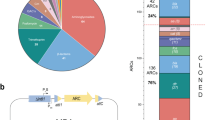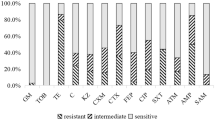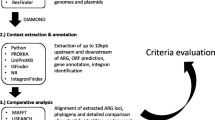Abstract
DNA sequencing, phylogenetic and mapping studies suggest that the class 1 integron found in pathogens arose when one member of the diverse family of environmental class 1 integrons became embedded into a Tn402 transposon. However, the timing of this event and the selective forces that first fixed the newly formed element in a bacterial lineage are still unknown. Biocides have a longer use in clinical practice than antibiotics, and a qac (quaternary ammonium compound) resistance gene, or remnant thereof, is a normal feature of class 1 integrons recovered from clinical isolates. Consequently, it is possible that the initial selective advantage was conferred by resistance to biocides, mediated by qac. Here, we show that diverse qac gene cassettes are a dominant feature of cassette arrays from environmental class 1 integrons, and that they occur in the absence of any antibiotic resistance gene cassettes. They are present in arrays that are dynamic, acquiring and rearranging gene cassettes within the arrays. The abundance of qac gene cassettes makes them a likely candidate for participation in the original insertion into Tn402, and as a source of a readily selectable phenotype. More broadly, the increasing use of qac and other biocides at the present time seems likely to promote the fixation of further novel genetic elements, with unpredictable and potentially adverse consequences for human health and agriculture.
Similar content being viewed by others
Log in or create a free account to read this content
Gain free access to this article, as well as selected content from this journal and more on nature.com
or
References
Bjorland J, Steinum T, Kvitle B, Waage S, Sunde M, Heir E . (2005). Widespread distribution of disinfectant resistance genes among staphylococci of bovine and caprine origin in Norway. J Clin Microbiol 43: 4363–4368.
Boucher Y, Labbate M, Koenig J, Stokes H . (2007). Integrons: mobilizable platforms that promote genetic diversity in bacteria. Trends Microbiol 15: 301–309.
Brown NL, Misra TK, Winnie JN, Schmidt A, Seiff M, Silver S . (1986). The nucleotide sequence of the mercuric resistance operons of plasmid R100 and transposon Tn501: further evidence for mer genes which enhance the activity of the mercuric ion detoxification system. Mol Gen Genet 202: 143–151.
Brown HJ, Stokes HW, Hall RM . (1996). The integrons In0, In2 and In5 are defective transposon derivatives. J Bacteriol 178: 4429–4437.
Datta N, Hughes VM . (1983). Plasmids of the same Inc groups in Enterobacteria before and after the medical use of antibiotics. Nature 306: 616–617.
Davies J . (2007). Microbes have the last word. EMBO Rep 8: 616–621.
D’Costa VM, McGrann KM, Hughes DW, Wright GD . (2006). Sampling the antibiotic resistome. Science 311: 374–377.
Dunwell J, Culham A, Carter C, Sosa-Aguirre C, Goodenough P . (2001). Evolution of functional diversity in the cupin superfamily. Trend Biochem Sci 26: 740–746.
Ebner P, Garner K, Mathew K . (2004). Class1 integrons in various Salmonella enterica serovars isolated from animals and identification of genomic island SGI1 in Salmonella enterica var. Melagridis. J Antimicrob Chemother 53: 1004–1009.
Essen-Zandbergen A, Smith H, Veldman K, Mevius D . (2007). Occurrence and characteristics of class 1, 2 and 3 integrons in Escherichia coli, Salmonella and Campylobacter spp. in the Netherlands. J Antimicrob Chemother 59: 746–750.
Frost L, Leplae R, Summers AO, Toussaint A . (2005). Mobile genetic elements: the agents of open source evolution. Nat Rev Microbiol 3: 722–732.
Gaze WH, Abdouslam N, Hawkey PM, Wellington EMH . (2005). Incidence of class 1 integrons in a quaternary ammonium compound-polluted environment. Antimicrobial Agents Chemother 49: 1802–1807.
Gilbert P, McBain A . (2003). Potential impact of increased use of biocides in consumer products on prevalence of antibiotic resistance. Clin Microbiol Rev 16: 189–208.
Gillings M, Holley M, Selleck M . (2006). Molecular identification of species comprising an unusual biofilm from a groundwater treatment plant. Biofilms 3: 19–24.
Gillings M, Boucher Y, Labbate M, Holmes A, Krishnan S, Holley M et al. (2008a). The evolution of class 1 integrons and the rise of antibiotic resistance. J Bacteriol 190: 5095–5100.
Gillings M, Krishnan K, Worden P, Hardwick S . (2008b). Recovery of diverse genes for class 1 integron-integrases from environmental DNA samples. FEMS Microbiol Lett 287: 56–62.
Gillings M, Holley M, Stokes H, Holmes A . (2005). Integrons in Xanthomonas: A source of species genome diversity. Proc Natl Acad Sci USA 102: 4419–4424.
Goldstein C, Lee M, Sanchez S, Hudson C, Phillips B, Register B et al. (2001). Incidence of class 1 and 2 integrases in clinical and commensal bacteria from livestock, companion animals, and exotics. Antimicrob Agents Chemother 45: 723–726.
Hall R, Collis C . (1995). Mobile gene cassettes and integrons: Capture and spread of genes by site-specific recombination. Mol Microbiol 15: 593–600.
Hall RM, Collis CM, Kim M-J, Partridge SR, Recchia GD, Stokes HW . (1999). Mobile gene cassettes in evolution. Ann NY Acad Sci 87: 68–80.
Hardwick S, Stokes HW, Findlay S, Taylor M, Gillings M . (2008). Quantification of class 1 integron abundance in natural environments using real-time quantitative PCR. FEMS Microbiol Lett 278: 207–212.
Higgins CS, Murtough SM, Williamson E, Hiom SJ, Payne DJ, Russel AD et al. (2001). Resistance to antibiotics and biocides among non-fermenting Gram-negative bacteria. Clin Microbiol Infect 7: 308–315.
Holmes A, Holley M, Mahon A, Nield B, Gillings M, Stokes H . (2003). Recombination activity of a distinctive integron-gene cassette system associated with Pseudomonas stutzeri populations in soil. J Bacteriol 185: 918–928.
Hughes VM, Datta N . (1983). Conjugative plasmids in bacteria in the ‘pre-antibiotic’ era. Nature 302: 725–726.
Kholodii GY, Mindlin SZ, mBass IA, Yurieva OV, Minakhina SV, Nikiforov VG . (1995). Four genes, two ends and a res region are involved in transposition of Tn5053: a paradigm for a novel family of transposons carrying either a mer operon or an integron. Mol Microbiol 17: 1189–1200.
Lane D . (1991). 16S/23S rRNA sequencing. In: Stackebrandt E, Goodfellow M (eds). Nucleic Acid Techniques in Bacterial Systematics. John Wiley and Sons: London, pp 115–175.
Langsrud S, Sundheim G, Holck AL . (2004). Cross resistance to antibiotics of Escherichia coli adapted to benzalkonium chloride or exposed to stress inducers. J Appl Microbiol 96: 201–208.
Liebert C, Hall R, Summers A . (1999). Transposon Tn21, flagship of the floating genome. Microbiol Mol Biol Rev 63: 507–522.
Michael C, Gillings M, Holmes A, Hughes L, Andrew N, Holley M et al. (2004). Mobile gene cassettes: A fundamental resource for bacterial evolution. Am Nat 164: 1–12.
Partridge S, Recchia G, Stokes H, Hall R . (2001). Family of class 1 integrons related to In4 from Tn1696. Antimicrob Agents Chemother 45: 3014–3020.
Poole K . (2005). Efflux-mediated antimicrobial resistance. J Antimicrobial Chemother 56: 20–51.
Recchia G, Hall R . (1995). Gene cassettes, a new mobile element. Microbiol 141: 3015–3027.
Rowe-Magnus D, Guerot A-M, Mazel D . (2002). Bacterial resistance evolution by recruitment of super-integron gene cassettes. Mol Microbiol 43: 1657–1669.
Russell AD . (2002). Introduction of biocides into clinical practice and the impact on antibiotic resistant bacteria. J Appl Microbiol Symp Suppl 92: 121S–135S.
Russell AD, Tattawasart U, Maillard J-Y, Furr JR . (1998). Possible link between bacterial resistance and use of antibiotics and biocides. Antimicrob Agents Chemother 42: 2151.
Stokes H, Holmes A, Nield B, Holley M, Nevalainen K, Mabbutt B et al. (2001). Gene cassette PCR: Sequence independent recovery of entire genes from environmental DNA. Appl Env Microbiol 67: 5240–5246.
Stokes H, Hall R . (1989). A novel family of potentially mobile elements encoding site-specific gene-integration functions: integrons. Mol Microbiol 3: 1669–1683.
Stokes H, Nesbø C, Holley M, Bahl M, Gillings M, Boucher Y . (2006). Class 1 integrons predating the association with Tn402-like transposition genes are present in a sediment microbial community. J Bacteriol 188: 5722–5730.
Tetu S, Holmes A . (2008). A family of insertion sequences that impacts integrons by specific targeting of gene cassette recombination sites, the IS1111-attc group. J Bacteriol 190: 4959–4970.
Toussaint A, Merlin C . (2002). Mobile elements as a combination of functional modules. Plasmid 47: 26–35.
White DG, McDermott PF . (2001). Biocides, drug resistance and microbial evolution. Curr Opinion Microbiol 4: 313–317.
Yeates C, Gillings M . (1998). Rapid purification of microbial DNA from soil for molecular biodiversity analysis. Lett Appl Microbiol 27: 49–53.
Acknowledgements
This study was supported by grants from the Australian Research Council and the National Health and Medical Research Council.
Author information
Authors and Affiliations
Corresponding author
Additional information
Supplementary Information accompanies the paper on The ISME Journal website (http://www.nature.com/ismej)
Supplementary information
Rights and permissions
About this article
Cite this article
Gillings, M., Xuejun, D., Hardwick, S. et al. Gene cassettes encoding resistance to quaternary ammonium compounds: a role in the origin of clinical class 1 integrons?. ISME J 3, 209–215 (2009). https://doi.org/10.1038/ismej.2008.98
Received:
Revised:
Accepted:
Published:
Issue date:
DOI: https://doi.org/10.1038/ismej.2008.98
Keywords
This article is cited by
-
Sub-inhibitory gentamicin pollution induces gentamicin resistance gene integration in class 1 integrons in the environment
Scientific Reports (2023)
-
The impact and mechanism of quaternary ammonium compounds on the transmission of antibiotic resistance genes
Environmental Science and Pollution Research (2019)
-
Antibiotic resistance genes in the Actinobacteria phylum
European Journal of Clinical Microbiology & Infectious Diseases (2019)
-
Conserved phylogenetic distribution and limited antibiotic resistance of class 1 integrons revealed by assessing the bacterial genome and plasmid collection
Microbiome (2018)
-
The widespread dissemination of integrons throughout bacterial communities in a riverine system
The ISME Journal (2018)



